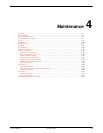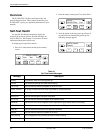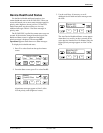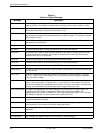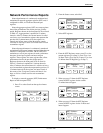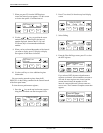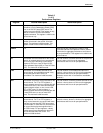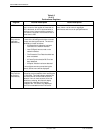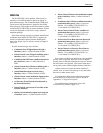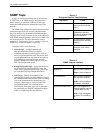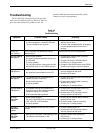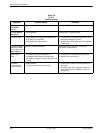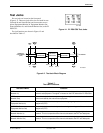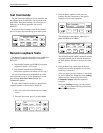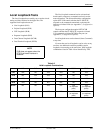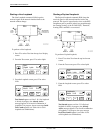
Maintenance
4-93170-A2-GB20-20 December 1996
Alarms
The E1 DSU/CSU can be attached, either locally or
remotely, to an ASCII terminal or printer to display or
print alarm messages. The Communications (COM) port
can be used as the destination for Alarm Set and Alarm
Clear messages. This enables an ASCII terminal or printer
to monitor the E1 DSU/CSU for alarm conditions. Alarms
can also be displayed on a PC that is using a terminal
emulation package.
Each alarm message contains a customer identification
to indicate which remote E1 DSU/CSU is reporting an
alarm. For information about customer identification,
refer to the Displaying Unit Identity
section in Chapter 3,
Operation.
Possible alarm messages are as follows:
• Continuous Loss Of Signal detected at the x
Interface (where x is either Network or DTE).
• Alarm Cleared. Loss of Signal condition at the x
Interface (where x is either Network or DTE).
• Continuous Out Of Frame condition detected at
the x Interface (where x is either Network or
DTE).
• Alarm Cleared. Out of Frame condition at the x
Interface (where x is either Network or DTE).
• Alarm Indication Signal received at the x
Interface (where x is either Network or DTE).
• Alarm Cleared. Alarm Indication Signal at the x
Interface (where x is either Network or DTE).
•
An Excessive Err
or Rate has been detected at
the Network Interface.
• Alarm Clear
ed. An Excessive Err
or Rate at the
Network Interface.
• Remote Alarm Indication signal received at the
x Interface (where x is either Network or DTE).
• Alarm Cleared. Remote Alarm Indication signal
at the x Interface (where x is either Network or
DTE).
• Continuous Out Of Frame condition detected at
synchronous data port n (where n is the port
number: 1–2 for Model 3172 DSU/CSUs, or
1–4 for Model 3174 DSU/CSUs).
• Alarm Cleared. Out Of Frame condition at
synchronous data port n (where n is the port
number: 1–2 for Model 3172 DSU/CSUs, or
1–4 for Model 3174 DSU/CSUs).
•
An Excessive Err
or Rate has been detected at
synchronous data port n (where n is the port
number: 1–2 for Model 3172 DSU/CSUs, or
1–4 for Model 3174 DSU/CSUs).
• Alarm Clear
ed. An Excessive Err
or Rate at
synchronous data port n (where n is the port
number: 1–2 for Model 3172 DSU/CSUs, or
1–4 for Model 3174 DSU/CSUs).
If two alarm conditions are detected at once, the higher
priority alarm is reported. However, if an even higher
priority alarm is detected before the first alarm is cleared,
the later alarm is not reported. (The alarms listed above
are in priority order with the highest priority listed first.)
Alarms remain active until the alarm condition is
cleared. Also, an alarm clear message is only sent when
there are no other alarms active.
For information about alarm configuration options,
refer to the
Alarm Configuration Options
section in
Appendix C, Configuration Options
.
For troubleshooting information, refer to the
Troubleshooting
section on page 4-1
1.



